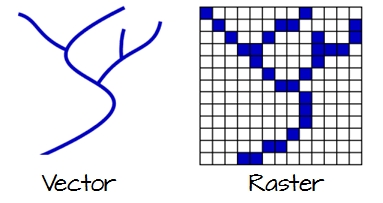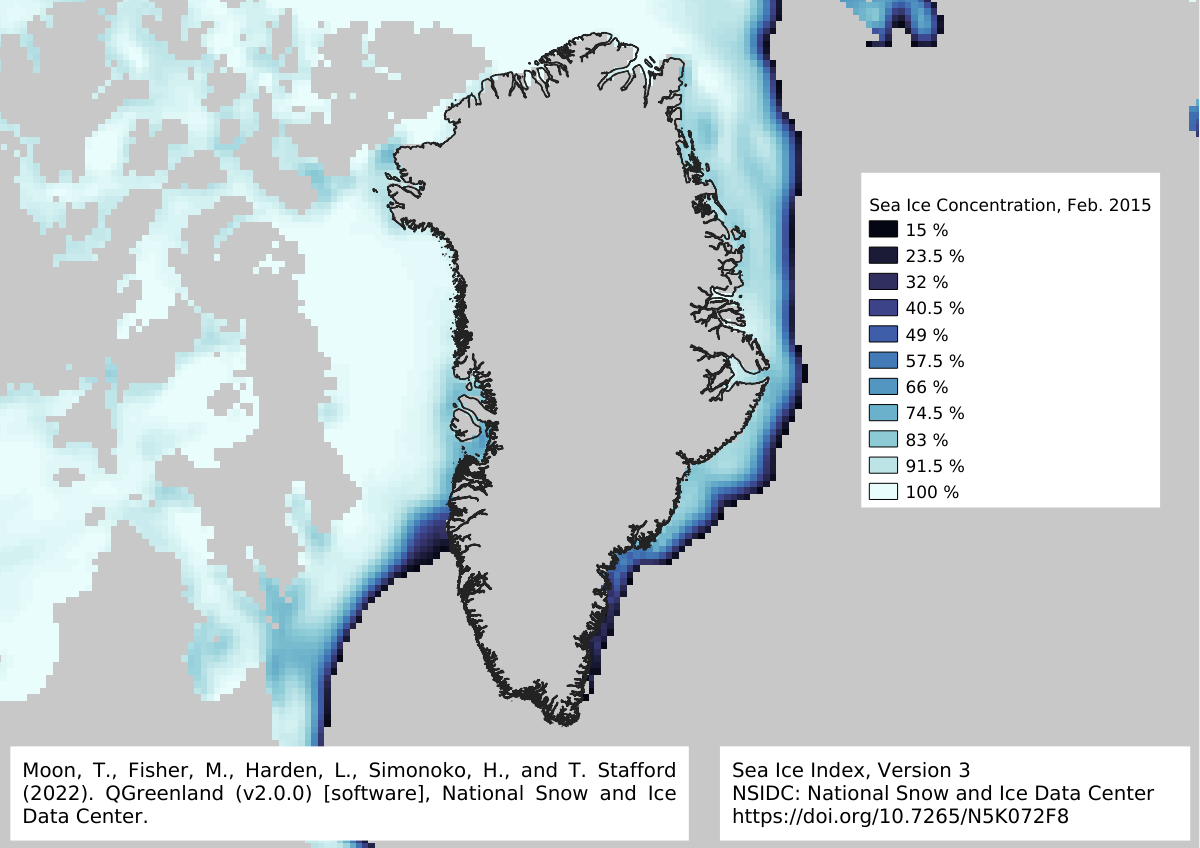Review: Geospatial concepts and terms
QGreenland Researcher Workshop 2023
Geospatial data

Vector data
Choose the right feature type:
- Point
- Line
- Polygon
Vector map (Wikimedia Commons)
Vector attributes
Attributes add additional data to a geospatial element
- A point representing a weather station may have a
temperatureattribute - a line representing a river may have a
nameattribute - A polygon representing a state may have a
populationattribute

Attribute table for the “Human activity/Research sites/GEM research stations” point layer in QGreenland
Vector topology
- Spatial relationships between vector features.
- E.g,
- “what points fall within a given polygon?”
- “What polygons are adjacent to this one?”

Examples of topological spatial relations (Wikimedia Commons)
Raster data
RGB Raster Image (Wikimedia Commons)
Raster data: continuous and categorical
Continuous: temperature, sea ice concentration, wind speed

Categorical: land cover, cloud type, storm category

Metadata
Data about data
Geospatial metadata concepts
- Location: where does a feature occur in space/on the Earth.
- Time: when did the feature occur?
- Provenance: Where did the data come from and what kind of processing was applied?
- Measurement information
- What units of measure is the feature recorded in?
- “Missing/No Data” and other flags
Coordinate Reference System (CRS) information
Includes all of the information necessary to accurately locate features on Earth.
- Geodetic datum
- Coordinate system
- Geographic (latitude/longitude)
- Projected (planar coordinates, usually in meters)
Note
Coordinate Reference System (CRS) == Spatial Reference System (SRS)
Geodetic Datums
A model representation of the Earth serving as a reference for locating features.
- Often a spherical or ellipsoidal representation.
WGS84is a common global datum, but many others exist (including locally best-fitting models).- Differences between datums can be significant (> 100 meters in some cases).

Geographic Coordinate System (GCS)
Coordinate system that represents locations on the Earth in spherical coordinates of latitudes and longitudes.

Diagram of the latitude ϕ and longitude λ angle measurements for a spherical model of the Earth (Wikimedia Commons)
Projected Coordinate System (PCS)
Coordinate system that represents locations on the Earth in planar coordinates (X, Y).
- Projection is the transformation of spherical (lat/lon) coordinates to a planar surface.
- Benefits include visualization on flat surfaces (e.g., maps) and simplified distance calculations.
- Projection results in one or more distortions: shape, area, distance, direction

Standard representations of CRS information
Well Known Text (WKT) 🌎
PROJCRS["WGS 84 / NSIDC Sea Ice Polar Stereographic North",
BASEGEOGCRS["WGS 84",
DATUM["World Geodetic System 1984",
ELLIPSOID["WGS 84",6378137,298.257223563,
LENGTHUNIT["metre",1]]],
PRIMEM["Greenwich",0,
ANGLEUNIT["degree",0.0174532925199433]],
ID["EPSG",4326]],
CONVERSION["US NSIDC Sea Ice polar stereographic north",
METHOD["Polar Stereographic (variant B)",
ID["EPSG",9829]],
PARAMETER["Latitude of standard parallel",70,
ANGLEUNIT["degree",0.0174532925199433],
ID["EPSG",8832]],
PARAMETER["Longitude of origin",-45,
ANGLEUNIT["degree",0.0174532925199433],
ID["EPSG",8833]],
PARAMETER["False easting",0,
LENGTHUNIT["metre",1],
ID["EPSG",8806]],
PARAMETER["False northing",0,
LENGTHUNIT["metre",1],
ID["EPSG",8807]]],
CS[Cartesian,2],
AXIS["easting (X)",south,
MERIDIAN[45,
ANGLEUNIT["degree",0.0174532925199433]],
ORDER[1],
LENGTHUNIT["metre",1]],
AXIS["northing (Y)",south,
MERIDIAN[135,
ANGLEUNIT["degree",0.0174532925199433]],
ORDER[2],
LENGTHUNIT["metre",1]],
USAGE[
SCOPE["unknown"],
AREA["World - N hemisphere - north of 60°N"],
BBOX[60,-180,90,180]],
ID["EPSG",3413]]Standard representations of CRS information
Proj parameters
+proj=stere +lat_0=90 +lat_ts=70 +lon_0=-45 +x_0=0 +y_0=0 +datum=WGS84 +units=m +no_defsStandard representations of CRS information
European Petroleum Survey Group (EPSG) Geodetic Parameter Dataset codes
EPSG:3413Metadata standards
When a dataset follows of one or more common standards, GIS practitioners and tools can accurately parse information about CRS, date/time, etc.
See the Continued learning page for examples of common standards.